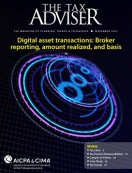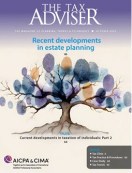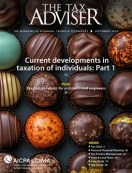- tax clinic
- FOREIGN INCOME & TAXPAYERS
Impact of the OECD global anti–base erosion model rules on GILTI
Related
IRS announces prop. regs. on international tax law provisions in OBBBA
QSBS gets a makeover: What tax pros need to know about Sec. 1202’s new look
IRS ruling clarifies treatment of R&D when computing the FDII deduction
Editor: Howard Wagner, CPA
The Organisation for Economic Cooperation and Development (OECD) has been steadfast in recent years in its efforts to overhaul the current corporate cross-border tax rules. The recent focus is in response to the digital economy and current operational trends of multinational organizations in low-tax jurisdictions. This focus is primarily designed to prevent race-to-the-bottom scenarios with respect to income tax rates within low-tax jurisdictions as well as shifting of tax collection of profits outside jurisdictions in which they are generated.
In October 2021, 137 countries of the OECD Inclusive Framework on Base Erosion and Profit Shifting initially agreed to a two-pillar reform framework. Pillar One generally aims to reallocate profits to countries where a large multinational’s clients are located, known as market jurisdictions. Pillar Two, the global anti–base erosion (GloBE) rules, proposes three interconnected tax rules: the qualified domestic top-up tax (QDMTT), the income inclusion rule (IIR), and the undertaxed profits rule (UTPR). Each rule may be instituted by Inclusive Framework member countries to meet the framework requirements. The Pillar Two rules would apply to multinational enterprise (MNE) groups with total consolidated revenues above €750 million in at least two of the four years immediately preceding the tested tax year.
General mechanics of the Pillar Two rules
Each rule analyzes a constituent entity’s effective tax rate (ETR) to determine potential top-up tax liability within a specific operating jurisdiction under the Pillar Two framework. The top-up tax is generally calculated based upon a top-up tax percentage, which is defined as the excess of the proposed global minimum ETR of 15% over the respective ETR in the jurisdiction. The top-up tax percentage, if greater than zero, is then applied to an amount of excess profit equal to net GloBE income minus a carve-out for tangible assets and payroll costs within the jurisdiction.
GloBE income or loss is based on the financial accounting income or loss of each constituent entity in the accounting standard of the MNE’s ultimate parent entity, with certain necessary adjustments under the GloBE rules. GloBE income or loss is further allocated to permanent establishments or through flowthrough entities if necessary.
A QDMTT is generally defined as a minimum tax that is included in a jurisdiction’s domestic law and that: (1) determines excess profits of a constituent entity; (2) increases any domestic tax liability on such profits to the minimum jurisdiction rate (e.g., at least 15%) for a fiscal year; and (3) is implemented and administered consistently with the GloBE rules and related guidance. The QDMTT rules generally operate in a way to reduce the amount of top-up tax that is payable under the IIR and UTPR rules. A QDMTT could apply to purely domestic groups, i.e., groups with no foreign subsidiaries or branches, or those that do not meet the €750 million threshold.
The IIR, the primary Pillar Two rule, imposes a minimum tax of 15% on the ultimate parent entity or intermediary parent entity in proportion to its ownership interests in any constituent entities that have excess profit taxed at a rate lower than 15%. The UTPR functions as a backstop to constituent entities with low-taxed income held through a chain of ownership that does not result in the low-taxed income being included under an IIR (e.g., dilutive ownership interests). In such case, the UTPR requires an adjustment that increases tax at the subsidiary level, typically in the form of a denial of a deduction. The adjustment applicable to MNE group entities is the amount necessary to meet the top-up tax threshold (i.e., as calculated under the IIR). Then, the amount is allocated among UTPR implementing jurisdictions, based on a formula, in proportion to the relative shares of assets and employees.
The OECD initially desired that the IIR and the UTRP would be effective from 2023 and 2024, respectively. However, these rules have not come into effect in any jurisdictions. While many Inclusive Framework member countries have announced plans to implement a minimum tax under the GloBE rules, only a few have passed GloBE legislation.
Potential impact of the Pillar Two framework on GILTI and US shareholders
Countries with a current minimum tax regime on foreign earnings (e.g., the United States), are required to update their rules to substantially meet the general requirements above. The U.S. global intangible low-taxed income (GILTI) regime is designed to tax the profits of foreign corporations owned more than 50% by U.S. shareholders that exceed a certain base percentage of tangible assets, generally known as the qualified business asset investment (QBAI) deduction. Such corporations are considered controlled foreign corporations (CFCs) for U.S. federal income tax purposes. A U.S. shareholder of a CFC is generally defined as any U.S. individual or entity that holds (directly, indirectly, or constructively) at least 10% of the total voting power or the total value of shares in a foreign corporation.
GILTI inclusions are subject to a tax rate of at least 10.5% (the ordinary corporate rate of 21% minus the deduction of up to 50% available for corporations under Sec. 250) for U.S. corporate shareholders of a CFC. Notably, the ETR on a GILTI inclusion is generally lower than the OECD’s 15% minimum tax requirement. Further, a GILTI inclusion is taxed on foreign net profits, as current GILTI rules allow losses incurred in one country to offset income earned in another country before applying the deduction applicable under Sec. 250 and the corporate income tax rate.
For the GILTI regime to comply with the GloBE rules, the United States would be required to update its international tax regime to be substantially similar to the minimum thresholds set by the Pillar Two rules.
In the meantime, guidance released in February 2023 (2023 administrative guidance) confirms how taxes imposed under a CFC tax regime should be allocated under a mechanical formula from the constituent entity owner that is subject to the CFC tax to the constituent entity through which the CFC income has arisen. In the 2023 administrative guidance, the GILTI regime is referenced as an example of a blended CFC tax regime (2023 administrative guidance, §2.10.1.4).
In other words, taxes paid by a U.S. MNE on GILTI will be respected as a CFC tax of a blended CFC tax regime under the GloBE rules and then allocated to the individual CFC jurisdictions for purposes of the top-up tax calculation. As a result, the allocated taxes would reduce the top-up tax amount under IIR or UTPR but not under QDMTT. The allocation methodology is set out for fiscal years that begin on or before Dec. 31, 2025, and end on or before June 30, 2027, generally in accordance with the scheduled reduction of the Sec. 250 deduction for GILTI. It will be assessed whether the allocation methodology would be allowed for fiscal years after the limited time period.
The Biden administration has indicated a willingness to increase the tax on corporations and their CFCs (see General Explanations of the Administration’s Fiscal Year 2024 Revenue Proposals (Greenbook)). The administration has proposed a reduction to the GILTI Sec. 250 deduction for corporations and a removal of the QBAI deduction that would increase the ETR to 21% on GILTI inclusions. In addition, it would require GILTI inclusions and foreign tax credits to be calculated on a country-by-country basis, whereby the netting of foreign profits or losses among different jurisdictions would no longer be permitted. These proposals to the U.S. international tax regime would presumably serve to meet the minimum tax rate and country-by-country requirements under the Pillar Two model rules. Given the current divided Congress, however, it is unlikely changes will occur before the 2024 U.S. elections.
Although the Pillar Two requirements would specifically apply only to MNEs with total consolidated revenues over €750 million, any future updates made to the GILTI regime would likely apply to all U.S. shareholders and their associated foreign profits or losses. Notably, as previously discussed, the 2023 administrative guidance specifically states that the application of a QDMTT may also be extended to groups below that revenue threshold and to “purely domestic groups, i.e., groups with no foreign subsidiaries or branches” (2023 administrative guidance §5.1.3.11).
Key takeaways
Although the 2023 administrative guidance confirms that the GILTI regime qualifies for a blended CFC tax regime, U.S. taxes paid on GILTI will not be taken into account in computing the ETR for QDMTT purposes. In other words, GILTI inclusions of U.S. taxpayers could be subject to a minimum tax in the jurisdictions that have implemented QDMTT under the GloBE rules.
Also, U.S. MNEs should be mindful that the proposed changes to GILTI may be revisited after the 2024 U.S. elections in the context of the Biden administration’s commitment to Pillar Two and the pressure from various countries implementing the IIR into law effective from 2024. Additionally, U.S. MNEs can also expect that foreign profits will potentially be subject to a higher U.S. tax rate on any applicable GILTI inclusions if any of the proposed changes are enacted.
Without IRS action to provide additional guidance, U.S. MNEs may find themselves unable to claim foreign tax credits for taxes paid under another country’s QDMTT or UTPR.
Editor Notes
Howard Wagner, CPA, is a partner with Crowe LLP in Louisville, Ky. For additional information about these items, contact Wagner at howard.wagner@crowe.com. Unless otherwise noted, contributors are members of or associated with Crowe LLP.














